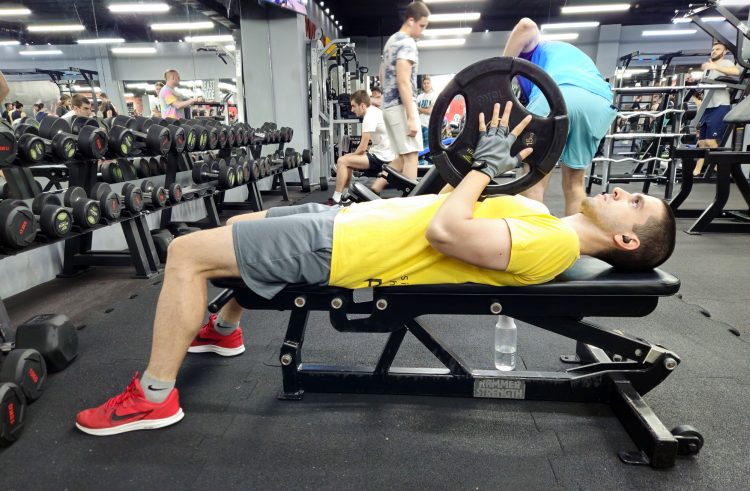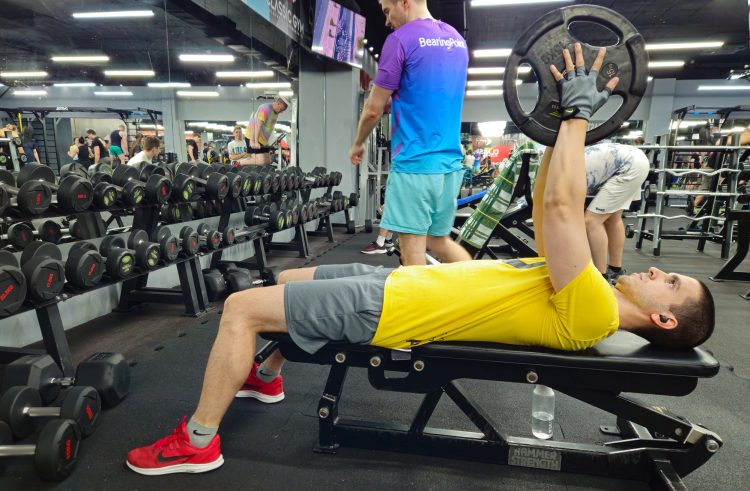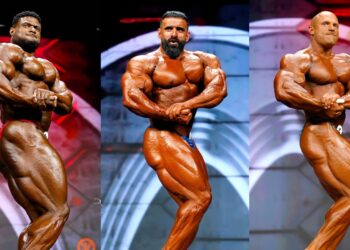We all want to build a massive chest. To achieve that goal, most primarily rely on different variations of the bench press with heavy weights to stimulate hypertrophy. However, the bench press does little for the inner chest.
You must prioritize inner chest development to improve overall aesthetics and build a balanced, powerful-looking physique.
The plate press is one of my favorite exercises for inner chest development, but it’s crucial to perform it with proper form to avoid injury and maximize results. Let’s learn how to do it correctly, its benefits, common mistakes, and alternatives.
How To Do Plate Press: Step-By-Step
Below is a detailed plate press instructional guide:
Step One — Set-Up
Hold a weight plate with your hands on the sides and lie on a flat bench on your back with your feet firmly on the ground. The center of your hands should be around the plate’s bore, and its bottom should rest on your chest (approximately on the sternum).
Level Up Your Fitness: Join our 💪 strong community in Fitness Volt Newsletter. Get daily inspiration, expert-backed workouts, nutrition tips, the latest in strength sports, and the support you need to reach your goals. Subscribe for free!
Pro Tip: Using multiple weight plates, known as the plate pinch press, enhances pec activation as it requires you to actively push the plates together.
Step Two — Grip and Positioning
Extend your elbows to lift the weight plate toward the ceiling. Avoid locking out your elbows at the top to maintain constant tension on the chest. This technique also limits joint strain and allows for better muscle engagement throughout the movement.
Pro Tip: Maximize chest engagement in the starting position by pressing your hands together as hard as possible.
Step Three — Lowering Phase
Slowly lower the weight plate to your chest by flexing your elbows. Flare your elbows on the eccentric phase to maximize chest fiber stimulation. Avoid crashing the plate on your chest, as it can crack the sternum.
Pro Tip: The negative (eccentric) phase is equally important to promote hypertrophy, so focus on time under tension.
Step Four — Pressing Phase
Once the weight plates lightly touch your chest, exhale and push the weight back to the top position. Pause in the fully shortened position for a second to maximize muscle stimulation. Repeat the movement for the desired number of reps. Aim for 8 to 12 reps.
Pro Tip: When pressing the weight plates upwards, drive through the heels of your hands rather than pushing through your fingertips. This will help you achieve peak chest contraction at the top of the range of motion (ROM).
Muscles Worked During Plate Press
The plate press primarily engages the following muscle groups:
Chest (Pectoralis Major)
The plate press primarily targets the pectoralis major muscle, which is responsible for heavy lifting, working to bring your arms across your body through shoulder horizontal adduction.
Shoulders (Deltoids)
As you press weight plates upward, your anterior deltoid helps lift your arms forward (shoulder flexion). Meanwhile, the lateral deltoid works to raise your arms out to the side (shoulder abduction).
Triceps
The triceps brachii, located at the back of your upper arm, are very important for this movement. They’re responsible for straightening your arms as you push those plates away from your body.
Core (Rectus Abdominis and Obliques)
The core is not in the spotlight, but those muscles are definitely putting in work during plate presses. Your rectus abdominis and oblique muscles keep your torso stable.
Jeff Nippard’s Take on the Plate Press and Convenience of the Exercise
Jeff Nippard, a Canadian natural pro bodybuilder with over four million YouTube subscribers, is not a big fan of the plate press. In a YouTube video analyzing the best chest exercises, Nippard placed the plate press at the bottom along with the hex press.
“The plate press is basically a hex press that feels even more awkward, with even less overload potential.” — Jeff Nippard
Benefits of Plate Press
Here are the pros of adding the plate press to your arsenal:
Inner Pecs Emphasis
A 2017 study indicated that grip width primarily changes EMG activity in the biceps and triceps brachii muscles, with limited influence on the pectorals. (1)
Level Up Your Fitness: Join our 💪 strong community in Fitness Volt Newsletter. Get daily inspiration, expert-backed workouts, nutrition tips, the latest in strength sports, and the support you need to reach your goals. Subscribe for free!
However, developing a well-defined chest, particularly the inner portion, has been a major challenge throughout my fitness journey. The plate press has helped me bridge the gap better than some other exercises like cable and dumbbell flyes. An advanced variation of this exercise (plate pinch press) requires holding the weight plates together and pressing them inward during the movement, leading to even better inner chest activation.
Versatility
One of the standout benefits of the plate press is its versatility. Whether you’re a beginner or an advanced lifter, you can fit this exercise into your regime. Furthermore, the plate press is not technically complicated, so even someone who has come to the gym for the first time can do it correctly.
The plate press can be performed on various surfaces, including flat benches, stability balls, or even the floor.
Core Stabilization
The core muscles are engaged throughout this exercise to ensure optimal stability and balance. For a more significant stability challenge, perform this exercise on an unstable surface like an exercise ball.
Common Mistakes During Plate Press
These plate press mistakes can hamper progress and contribute to injuries:
Using Excessive Weight
Using excessive weight in the plate press can do more harm than good. It hampers form, limits range of motion, and increases the risk of injury.
When you lift weights that are too heavy for you, your form suffers as your body recruits supporting muscles to move the load. This removes tension from the target muscles and increases injury risk.
So, forget about ego lifting and focus on proper form and safety.
Flaring Elbows
Avoid flaring your elbows during the plate press exercise, as it can shift the focus from the chest to the shoulders. This means you’re not getting the most out of this exercise in terms of chest development and strength gains.
Focus on keeping your elbows close to your body throughout the entire range of motion.
Using Arms More Than Chest
I must admit this was a mistake I often made during my first year at the gym. Once I noticed that I was feeling soreness in my triceps and not my pecs, I realized I was doing something wrong.
Usually, there are two reasons why you use your arms more than your pecs in this exercise. The first reason is excessive weight, and the second is poor grip on the plate. Drive your elbow pits together on the concentric phase to maximize chest stimulation.
Alternatives to Plate Press
These three exercises are suitable alternatives to the plate press:
Cable Chest Press
The cable chest press provides constant tension throughout the movement, which is why I usually implement it in my clients’ fitness plans. You can customize the exercise to target different parts of the chest by adjusting the cable height and hand positioning.
How To:
- Adjust the cable handles to chest height.
- Stand facing away from the cable machine with your feet shoulder-width apart and knees slightly bent.
- Grasp handles with an overhand grip.
- Extend your arms straight out in front of you, parallel to the floor.
- Engage your core and maintain a slight bend in your elbows throughout the exercise.
- Exhale as you push the handles forward, extending your arms in front of you.
- Pause briefly at full extension.
- Then, inhale as you slowly return to the starting position.
Pro Tip: Keep your shoulders down and back to emphasize the pecs.
Diamond Push-Ups
Push-ups are still one of the most effective exercises for pecs and triceps.
Diamond push-ups, also known as triangle push-ups, are a challenging variation of traditional push-ups that primarily target the inner chest, triceps, and front delts.
How To:
- Start in a high plank position.
- Put your hands close together, directly beneath your chest, forming a diamond shape with your thumbs and index fingers.
- Keep your body in a straight line from head to heels.
- Engage your core and glutes to maintain stability.
- Lower your chest towards the floor until your chest almost touches the backs of your hands.
- Explosively push through your palms to extend your arms and return to the starting position.
Pro Tip: Use the decline diamond push-up as a progression exercise to maximize target muscle stimulation.
Hex Press
The hex press is a variation of the traditional dumbbell bench press that increases inner pec activation. I like this exercise for building upper body strength and muscle definition while minimizing strain on the shoulders and wrists.
How To:
- Lie on a flat bench.
- Hold a dumbbell in each hand with a neutral grip and press the dumbbells together.
- Extend your arms straight above your chest, but stop just shy of locking out your elbows.
- Lower the dumbbells towards your chest.
Pro Tip: Focus on squeezing your chest muscles at the top of the movement.
Wrapping Up
Incorporating plate presses into my clients’ exercise plans has proven instrumental in breaking through the upper body strength and muscle development plateaus.
Achieving optimal results on the plate press hinges on adhering to correct form, emphasizing muscle activation, and steering clear of typical errors.
References
- Saeterbakken AH, Mo DA, Scott S, Andersen V. The Effects of Bench Press Variations in Competitive Athletes on Muscle Activity and Performance. J Hum Kinet. 2017 Jun 22;57:61-71. doi: 10.1515/hukin-2017-0047. PMID: 28713459; PMCID: PMC5504579.
Interested in measuring your progress? Check out our strength standards for Bench Press, Push Ups, Dumbbell Bench Press, and more.











